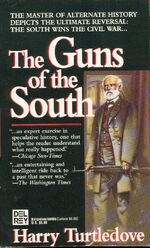The Constitution of the Confederate States of America was the supreme law of the Confederate States, as adopted on March 11, 1861 and in effect through the conclusion of the American Civil War. The Confederacy also operated under a Provisional Constitution from February 8, 1861 to March 11, 1861.
In regard to most articles of the Constitution, the document is a word-for-word duplicate of the United States Constitution. However, there are crucial differences between the two documents, in tone and legal content.
Confederate States Constitution in The Guns of the South[]
Provisions of the Confederate States Constitution, specifically article one, section nine, clause four which stated "No bill of attainder, ex post facto law, or law denying or impairing the right of property in Negro slaves shall be passed" proved to be an "impediment" to President Robert E. Lee's intention to slowly abolish this peculiar institution.[1] However, his legislation on the matter eventually passed in 1868. Lee did reflect that the failure, to date, to establish a Supreme Court, as also required by the Constitution, would allow the law to stand and begin work smoothly before it could be eventually reviewed.[2]
Confederate States Constitution in Southern Victory[]
The Confederate States Constitution was amended only a few times during the history of the Confederate States. Most notably, it was amended after the Second Mexican War to legally end slavery. Somewhat ironically, it was the votes of the states of Sonora and Chihuahua, the purchase of which had caused the Second Mexican War in the first place, that made the amendment possible.[3]
Following the midterm elections of November 1937, at the direction of President Jake Featherston, the states of South Carolina and Mississippi called for a constitutional convention which would remove the language that limited a presidential term to one single six-year term.[4] The Freedom-dominated Confederate Congress and state legislatures easily ratified the Seven Words Amendment by the end of 1938.[5] Featherston was now allowed to run for re-election for as many times as he wanted.
Literary comment[]
Neither of the known amendments is numbered.
Confederate States Constitution in Supervolcano[]
Bryce Miller held up the Confederate States Constitution as evidence of the fact that slavery was the primary cause of the Civil War in the U.S. history class he taught at Junipero High School. He explained that it was modeled on the U.S. Constitution but some parts were different, specifically Article One, Section Nine, Part Three which prohibited the passage of any law limiting the right of property in Negro slaves. He also mentioned that several other parts of this constitution talked about the right of slaveholders to keep their property.[6]
See Also[]
- The United States Constitution, upon which the Confederate States Constitution was heavily based.
References[]
- ↑ The Guns of the South, pgs. 386-388, MPB.
- ↑ Ibid, pgs 552-554.
- ↑ American Front, pgs. 17-18.
- ↑ The Victorious Opposition, pg. 302-304 mmpb.
- ↑ Ibid., pg. 304.
- ↑ All Fall Down, pgs. 199-200, HC.
| |||||||||||||||||||
| |||||||||||||














